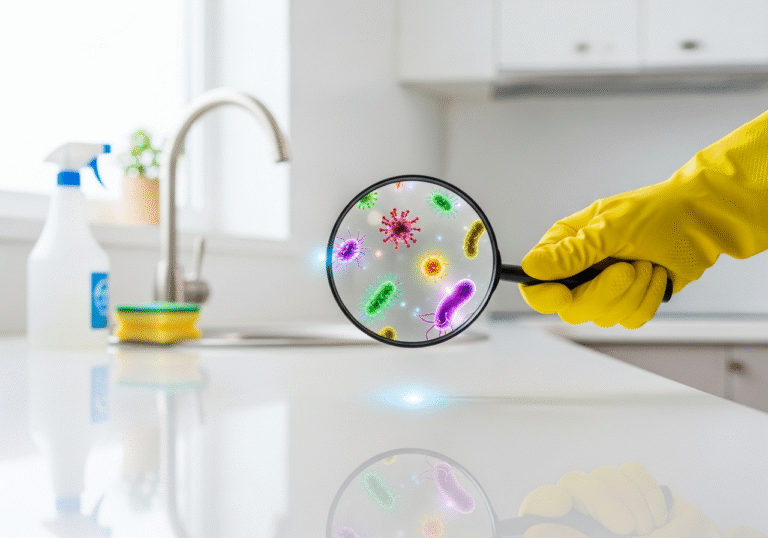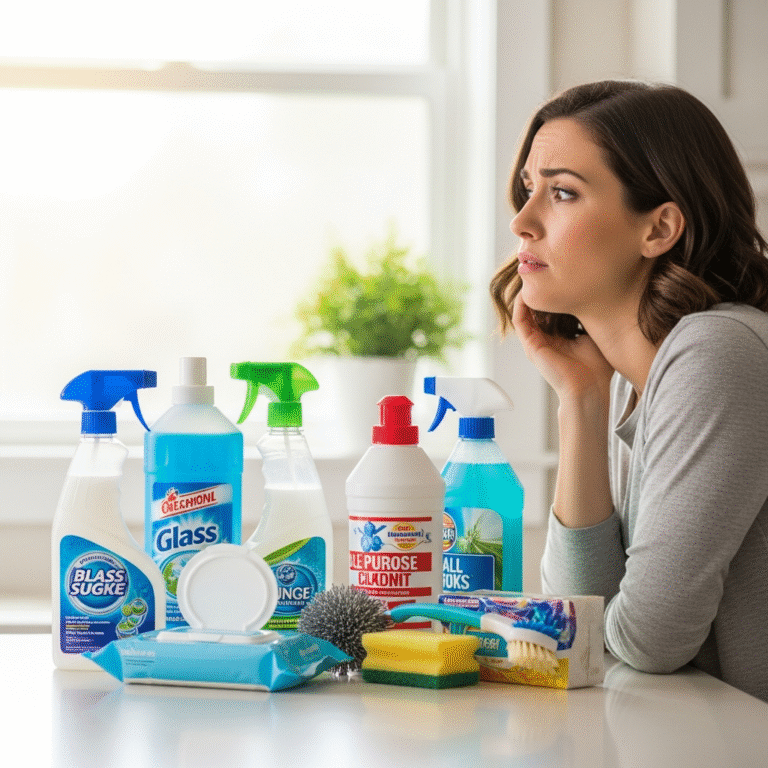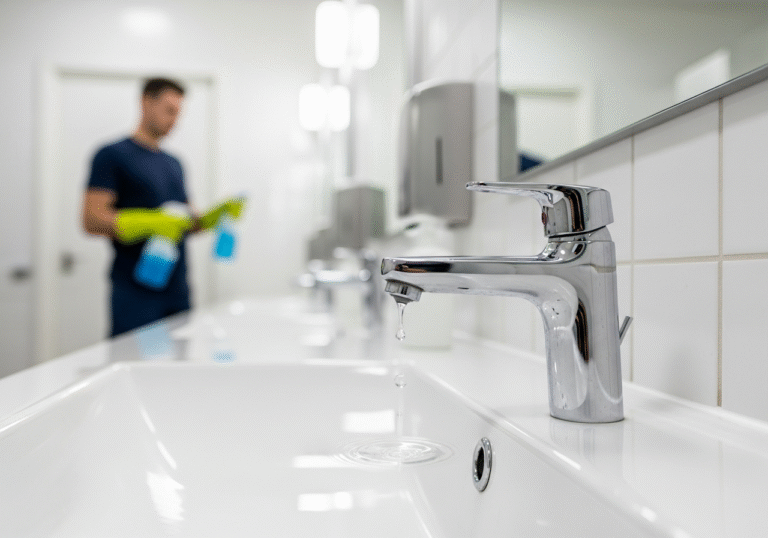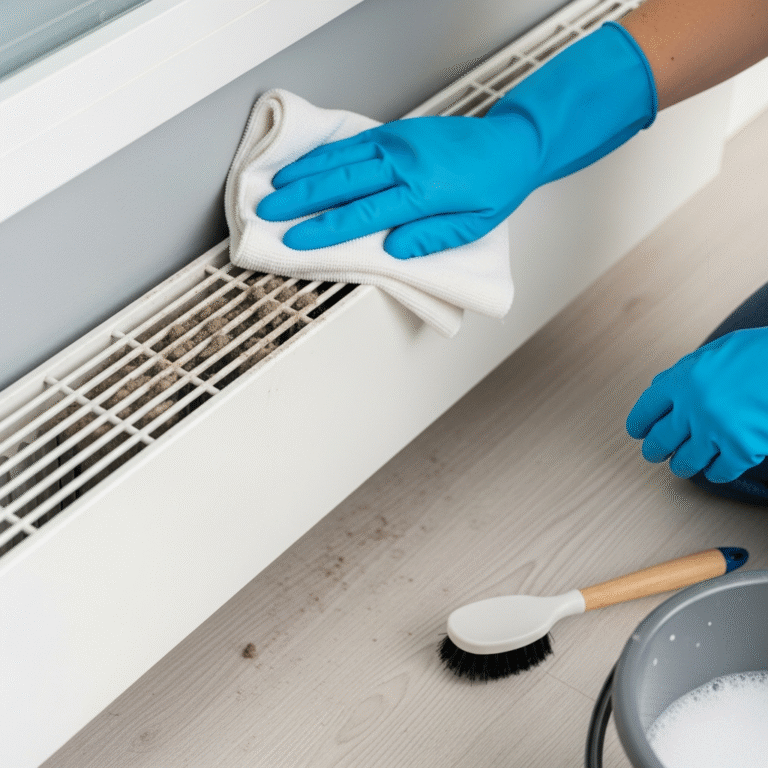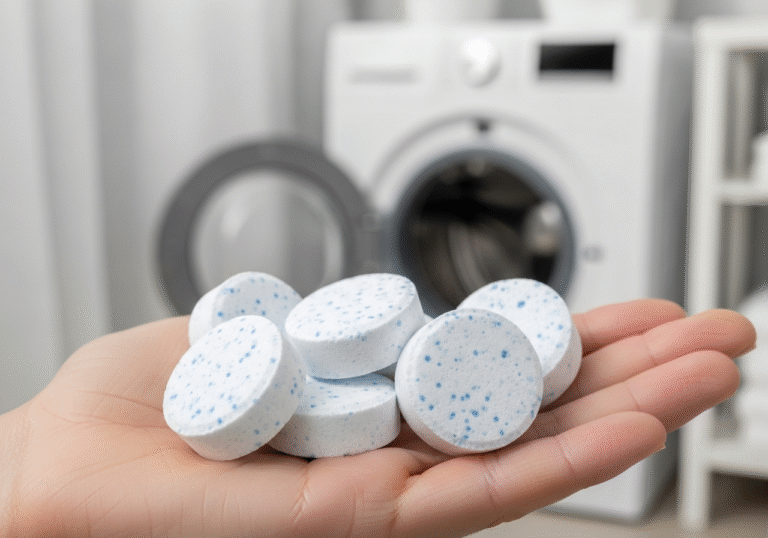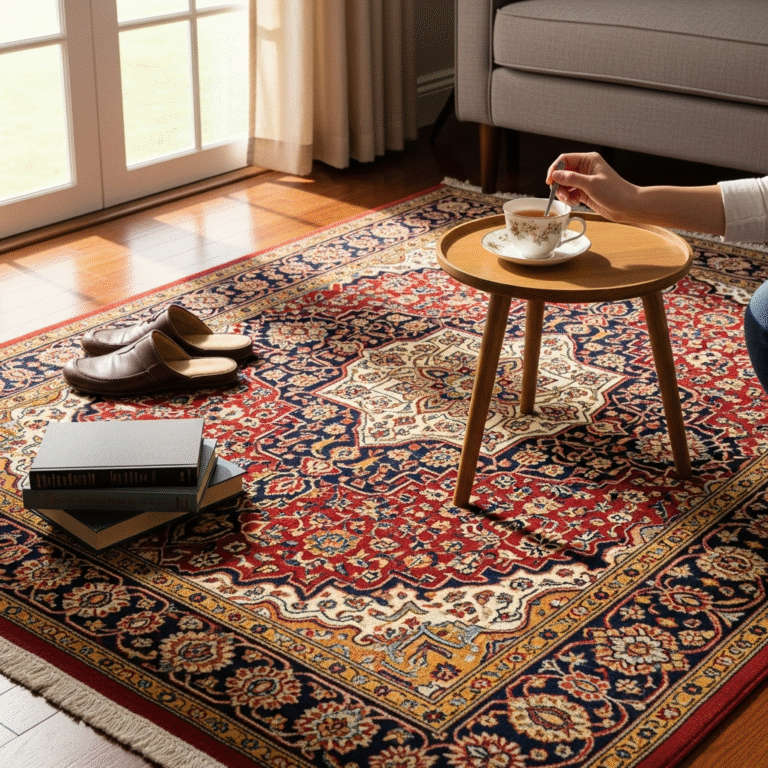Spring Cleaning Tasks is here, and that means it’s time to shake off the winter blues and give your home a fresh start with a thorough spring cleaning. But let’s be real: not all cleaning tasks are created equal. Some are absolutely crucial to ensure your home not only looks sparkling clean but also becomes a healthier environment for you and your family. So, grab your gloves, and let’s dive into the 7 spring cleaning tasks you really can’t afford to skip.
1. Dusting Off the Forgotten Spots
It’s easy to remember to swipe a cloth over the surfaces we see and use every day, but it’s those out-of-sight places that can secretly impact the freshness and healthiness of our living spaces.
Take the top of your fridge, for example. It’s a prime real estate for dust bunnies and kitchen grime, thanks to its warm, elevated location. This spot can easily become a hidden dust magnet, collecting particles that can eventually circulate back into your kitchen. Using a step stool, give this area a thorough wipe-down with a damp cloth or an extendable duster to capture and remove the grime. For an added sparkle, consider using a mild cleaning solution that can cut through kitchen grease and leave the surface clean and hygienic.
Ceiling fans, on the other hand, are notorious for spreading dust throughout the room every time they’re switched on. It’s ironic, isn’t it? A device meant to circulate air and keep you cool can also be distributing dust particles. Before the warmer weather kicks in and you find yourself reaching for that fan switch more often, ensure you clean the blades. A pillowcase can be a handy tool here: slip it over each blade in turn to trap the dust as you wipe, minimizing the mess.
And then there’s the matter of baseboards. These low-lying ledges can gather a surprising amount of dust and are often overlooked during regular cleaning sessions. However, they play a significant role in the overall cleanliness and appearance of your home. A quick run along these surfaces with a damp cloth or duster can make a big difference. For those stubborn spots, a gentle cleaning agent can help remove scuffs and marks, leaving your baseboards looking as good as new.
2. Window Washing
Window washing is one of those spring cleaning tasks that can truly rejuvenate your home, making it feel more open, airy, and full of life. But let’s delve deeper into why and how giving your windows a thorough cleaning can make such a significant difference, and some additional tips to make this task easier and more effective.
First off, consider the psychological impact of clean windows. They not only improve the aesthetic appeal of your home but also have a profound effect on your mood and well-being. Natural light has been shown to boost mood, enhance productivity, and even improve sleep by helping to regulate our natural circadian rhythms. By removing the layers of dirt, dust, and grime that have built up over the colder months, you’re allowing more sunlight to penetrate your home, which can help shake off the winter blues.
When tackling window washing, it’s important to choose the right day. A cloudy, but dry day is ideal because direct sunlight can cause the cleaning solution to dry too quickly, leaving streaks. Start with removing any dust from the window frame and screen with a brush or vacuum, to prevent dirt from mixing with your cleaning solution.
For the cleaning solution, you can either use a commercial window cleaner or make your own with a mixture of water and vinegar. This eco-friendly alternative does a fantastic job of breaking down grime without leaving streaks. Apply the solution with a sponge or soft cloth, and then use a squeegee for a smooth, streak-free finish. Wipe the squeegee blade with a clean cloth after each pass to avoid transferring dirt back onto the window.
Don’t forget the importance of cleaning both the inside and outside of the windows. Accessing the exterior side of windows can be more challenging, especially for those on higher floors. Safety should be your top priority, so use a long-handled squeegee for hard-to-reach spots or consider hiring professionals for those areas that are too risky to tackle on your own.
While it’s easy to focus on the glass, paying attention to the window frames and sills is equally important. These areas can harbor mold and mildew, particularly in older homes. Wipe them down with a damp cloth and, if necessary, a mild detergent. This not only completes the clean look of your windows but also contributes to the overall upkeep and longevity of the window frames.

3. Deep Clean the Carpets
Deep cleaning the carpets is indeed a crucial step in your spring cleaning routine, not just for aesthetic reasons but also for the health and longevity of your carpeting. Let’s explore further the significance of this task and provide some additional insights and tips to make your carpet cleaning efforts more effective.
The accumulation of dirt, salt, and debris over the winter months can not only dull the appearance of your carpets but also wear down the fibers, leading to premature aging and the need for replacement sooner than expected. More importantly, carpets can trap allergens, dust mites, and other pollutants, potentially affecting the air quality in your home and the health of your family, especially those with allergies or respiratory issues.
While vacuuming is an excellent routine maintenance step, it often only removes surface dirt and debris. A deeper clean is necessary to extract the grime that has settled deep within the carpet fibers. This is where renting a steam cleaner or hiring a professional carpet cleaning service comes into play. Steam cleaning, also known as hot water extraction, uses high temperatures to loosen dirt and a powerful vacuum to remove it from the carpet. This method not only cleans more effectively but also kills bacteria and dust mites, providing a healthier environment for your home.
If you opt for a DIY approach with a rented steam cleaner, it’s important to follow the instructions carefully. Pre-treat any stains or high-traffic areas with a suitable cleaning solution to ensure the best results. Be cautious not to over-wet the carpet, as excessive moisture can lead to mold and mildew growth. After cleaning, allow the carpet to dry completely, ideally with good ventilation or fans to speed up the process.
For those considering professional carpet cleaning services, doing some research and selecting a reputable company is key. Professionals have access to more powerful equipment and advanced cleaning solutions that can extend the life of your carpets and ensure a deeper clean. They can also offer specific treatments for pet odors, stains, and applying protectants that help repel dirt and spills, making future cleaning easier.
4. Decluttering
When you begin the decluttering process, you’re not just sorting through physical items; you’re also making decisions about what you value and what serves a purpose in your life. This process can be surprisingly emotional and liberating. As you sift through belongings, consider not only their utility but also the joy, or lack thereof, they bring into your life. This mindful approach to decluttering can help you create a space that truly reflects and supports your current lifestyle and aspirations.
One effective strategy is to tackle decluttering one room at a time, starting with the areas that are most cluttered or cause you the most stress. This focused approach prevents the task from becoming overwhelming and allows you to see tangible progress quickly. As you work through each space, categorize items into those you wish to keep, donate, sell, or discard. For items that are harder to part with, consider whether they have a designated place in your home or if they could serve someone else better.
Decluttering also offers a great opportunity to rethink your storage solutions. Once you’ve pared down your possessions, invest in organizational systems that make it easy to maintain a clutter-free environment. Clear, labeled bins, drawer organizers, and shelves can all help keep your remaining items neatly stored and accessible.
The psychological benefits of decluttering are substantial. A cluttered space can lead to a cluttered mind, with studies showing that excess belongings can increase stress and make it harder to focus. By clearing out unnecessary items, you’re also clearing mental space, leading to reduced stress levels and a greater sense of calm. Furthermore, a decluttered and organized home can save you time and frustration by making it easier to find what you need when you need it.
Moreover, decluttering can have a positive impact beyond your own home. Donating items that are no longer needed not only helps those in need but also promotes a culture of sustainability and reuse. It’s a win-win situation where you can declutter your home while contributing to the well-being of your community and the environment.
5. Cleaning Out the Fridge and Pantry
Embarking on this task, it’s best to approach it methodically. Start by emptying each shelf and drawer in the fridge and the pantry. This might seem daunting, but it’s the only way to truly assess what you have, what you need, and what’s no longer serving you. As you remove items, take the opportunity to wipe down the surfaces with a safe, food-grade cleaner or a simple solution of water and vinegar. This not only removes crumbs and spills but also sanitizes the surfaces, reducing the risk of contamination and keeping your food fresher for longer.
As you sort through your items, pay close attention to expiration dates and the condition of the food. Discarding expired products is a no-brainer, but also consider getting rid of items that, while not technically expired, have lost their quality or appeal. These might include stale spices that have lost their flavor, condiments that are nearing their end, or any food that you realistically will not consume.
This process also encourages a critical evaluation of your eating habits. As you sort and organize, you might notice patterns in your food purchases — perhaps a tendency to buy certain snacks that don’t align with your health goals or an overstock of certain ingredients you rarely use. This awareness can guide you to make more mindful choices in the future, leading to a healthier diet and less waste.
Once you’ve pared down your items, consider implementing an organizational system that makes sense for your lifestyle. Group similar items together, and place healthier choices at eye level to encourage better eating habits. Use clear containers to store leftovers and bulk items, making it easy to see what you have at a glance and reducing the chance of items being forgotten and going bad.

6. Refreshing Beddings and Upholstery
When you consider the amount of time spent in close contact with beddings, pillows, and upholstered furniture, it’s clear why maintaining their cleanliness is so critical. Over time, these items accumulate a significant amount of body oils, sweat, dead skin cells, and potentially, spill residues. This not only affects their appearance and smell but also makes them a breeding ground for dust mites and other allergens, which can significantly impact your health, especially if you suffer from allergies or asthma.
To start, focus on the items that don’t get washed as often as your regular bed linens. Duvets, comforters, and pillows should ideally be cleaned at least twice a year, and spring is a perfect time for one of those cleanings. Many of these items can be machine washed, but always check the care labels first to avoid damaging the materials. For items that are too large for your home washing machine, professional cleaning may be necessary, but it’s a worthwhile investment for the freshness and longevity it brings to these items.
Curtains are another often-neglected area that can collect a lot of dust and absorb odors from the home, altering the scent and air quality of your rooms. Most curtains are machine washable, but again, check the labels to ensure proper care. For delicate materials, steam cleaning can be an effective alternative, removing dust and refreshing the fabric without risking shrinkage or damage.
For removable upholstery covers, such as those on some sofas and chair cushions, give them a thorough wash according to the manufacturer’s instructions. This not only revitalizes their look but also helps remove any accumulated dirt and allergens. For non-removable upholstery, a deep vacuum followed by steam cleaning can do wonders for reviving the fabric’s appearance and hygiene.
Beyond cleaning, this is also an excellent opportunity to assess the condition of these items. Pillows, for example, lose their support over time and should be replaced every 1-2 years. Inspecting your bedding and upholstery as you clean allows you to identify any items that need repair or replacement, ensuring that your home remains a comfortable and healthy environment.
Finally, after cleaning, take steps to protect these items and extend the time between deep cleans. Using mattress and pillow protectors can significantly reduce the amount of sweat and skin cells that penetrate into the items, making them easier to maintain. Similarly, regularly vacuuming upholstered furniture and using throws or covers can protect against daily wear and tear.
7. Servicing Your HVAC System
An HVAC system that’s well-maintained does more than just heat or cool your space; it filters out pollutants, allergens, and dust that can compromise the air quality in your home. Over time, these systems can become less efficient due to accumulated dirt and wear on their components, leading to potential health issues and increased energy usage. Regular servicing ensures that your system is not only operating at its best but also keeping your indoor air clean and healthy.
Changing the filters is the most straightforward and immediate action you can take to maintain your system. Filters play a key role in trapping dust, pollen, and other airborne particles. Over time, however, they become clogged, reducing airflow and forcing the system to work harder, which in turn can lead to higher energy bills and reduced lifespan of the system. Depending on your system and the filter type, it’s recommended to change them every 1-3 months. This simple step can significantly impact the effectiveness of your HVAC system and the quality of air in your home.
For more comprehensive maintenance, a professional HVAC service is invaluable. Technicians can perform a detailed inspection and cleaning of the system’s components, including coils and ducts, that you can’t easily access yourself. They can also identify and fix any potential issues before they become major problems, such as leaks in the ductwork or malfunctioning parts. This proactive approach can prevent unexpected breakdowns, ensure your system operates efficiently, and extend its overall lifespan.
An efficiently running HVAC system is more energy-efficient, which translates into lower utility bills. Professionals can calibrate your system to ensure it’s running as efficiently as possible, offering advice on settings and even suggesting upgrades or changes that could lead to further savings. For example, installing a programmable thermostat can optimize your heating and cooling schedules, reducing energy use when you’re not home.
Doing Spring Cleaning Tasks
Spring cleaning embodies a spirit of renewal and rejuvenation, transforming it from a series of chores into an opportunity to breathe new life into your home. Embracing these seven critical tasks not only uplifts the physical space but also enhances the overall well-being of its inhabitants. It’s a seasonal ritual that redefines your living environment, making it more welcoming, efficient, and conducive to health and happiness. As the sunlight begins to fill your rooms more generously, you’ll find that a well-maintained home mirrors the brightness and warmth of the season outside. It’s about more than cleanliness; it’s about creating a sanctuary that reflects and supports your best life.
However, we understand that the breadth of spring cleaning can sometimes feel overwhelming, especially when balancing the demands of daily life. Whether it’s the deep cleaning of carpets that seems like a Herculean task, or the intricacies of servicing an HVAC system, some jobs might call for a touch of professionalism. This is where Toronto Shine Cleaning steps in. Specializing in a wide range of cleaning services, from deep cleaning to specialized tasks like HVAC maintenance, they can help take the weight off your shoulders. With their expertise, you can ensure that every nook and cranny of your home gets the attention it deserves, freeing you to focus on enjoying the season and the refreshed space you’ve created.
So, as you embark on your spring cleaning journey, remember that support is just a call away with Toronto Shine Cleaning. Their team of professionals can provide the assistance you need to ensure your home is sparkling clean, healthy, and ready to welcome the joys of spring and summer.















